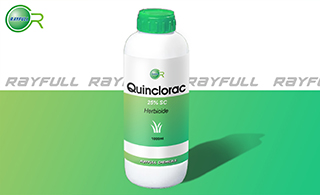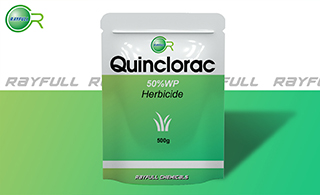Quinclorac
    二氯喹啉酸 二氯喹啉酸
Introduction: Quinclorac is a selective herbicide used primarily to control weeds in rice crops, but is also used on other agricultural crops and is found in some household herbicides for lawn use. Most lawn maintenance companies use the product for the control of annual grass weeds like crabgrass. Quinclorac is considered a synthetic auxin.
Common name: Quinclorac
Another name: 3,7-Dichloroquinoline-8-carboxylic acid; Quinchlorac; 3,7-Dichloro -8-quinolinecarboxylic acid; Facet; Quinclorac tech; Quinclorac [ISO]; UNII-3J06V625EE; etc.
Chemical name: 3,7-dichloroquinoline-8-carboxylic acid
Empirical formula: C10H5Cl2NO2
Structural formula:

Mol. Weight: 242.06 g/mol
CAS No.: 84087-01-4
Specifications
Leading Quinclorac supplier
Quinclorac 95% TC
Quinclorac 90% TC
Quinclorac 50% WP
Quinclorac 25% SC
Packing:
BULK PACKING
Powder: 25kg/Bag, 25kg/Drum, 50kg/Drum etc.
Liquid: 200L/Drum, 20L/Drum, 10L/Drum etc.
SMALL PACKING
Powder: 1kg/Alu bag, 500g/Alu bag, 200g/Alu bag, 100g/Alu bag, 50g/Alu bag, 15g/Alu bag etc.
Liquid: 5L/Drum, 1L/Bottle, 500ml/Bottle, 250ml/Bottle, 100ml/Bottle, 50ml/Bottle etc.
Customerized packing label
Quinclorac FAO standard
Professional registration
HAZARDS IDENTIFICATION
Hazard statement(s)
H317 (100%): May cause an allergic skin reaction.
Precautionary statement(s)
P261: Do not breathe dust/fume/gas/mist/vapors/spray.
P272: Contaminated work clothing should not be allowed out of the workplace.
P280: Wear protective gloves/protective clothing/eye protection/face protection.
P302+P352: IF ON SKIN: wash with plenty of water.
P321: Specific treatment (see ... on this label).
P333+P313: IF SKIN irritation or rash occurs: Get medical advice/attention.
P363: Wash contaminated clothing before reuse.
P501: Dispose of contents/container to an approved waste disposal plant.
Supplemental Hazard Statements: none.
MAMMALIAN TOXICOLOGY
Acute toxicity: 1) Acute oral LD50 for rats is 2680 a.i.mg/kg. 2) Acute dermal LD50 for rats is >2000 a.i.mg/kg. 3) Acute inhalation toxicity LC50 (4 h) for rats is >5.15 a.i.mg/L. 4) Skin irritation: Non-irritating to skin (rabbits). 5) Eye irritation: Slightly irritating to eyes (rabbits). 6) Skin sensitization for guinea pig: Not a sensitiser.
NOEL: (2 y) for rats is 529 mg/kg/day; (78 w) for mice is 52 mg/kg/day. Other Not carcinogenic. Not genotoxic.
ADI (JMPR) 0-0.4 mg/kg b.w. [2015]
Classification:
WHO Classification: III (Slightly hazardous)
EC Risk Classification: Xn - Harmful: R43
US EPA Classification (formulation): III (Caution - Slightly toxic )
ECOTOXICOLOGY
Effect on birds: Acute oral LD50 for Mallard is 2000 a.i.mg/kg. Effect on fish: Acute LC50 (96 h) for Rainbow trout is 100 a.i.mg/l. Effects on aquatic invertebrates: Acute EC50 (48 h) for Daphnia magna is 29.8 a.i.mg/l. Effects on algae: Acute 72 hour EC50 for Scenedesmus acutus is 6.53 a.i.mg/l. Effects on bees: contact acute 48 hour LD50 is 181 a.i.μg/bee.
ENVIRONMENTAL FATE
Animals More than 90% of radiolabelled quinclorac administered orally to rats is excreted in the urine within 5 days. Plants In plants, systemically translocated to the roots and to the leaves. Soil/Environment Only slightly adsorbed by the soil. Depending on soil type and organic matter content, the chemical is relatively mobile, this mobility increasing with higher percolation rates in fields. Quinclorac is degraded by micro-organisms, 3-chloro-8-quinolinecarboxylic acid being a major metabolite. Water regimes causing changes in moisture content in rice soils enhance the microbial degradation. Photolytic decomposition in active paddy water occurs in the presence of sunlight and dissolved humic acids.
Usage: Quinclorac was introduced by BASF AG. It is a herbicide used for post-emergence weed control on grass and turf.
Application: Biochemistry: Protein synthesis inhibitor. Mode of action: Selective herbicide, absorbed by the shoots of germinating plants. Uses: Pre-emergence or pre-plant incorporated for control of annual grasses and some broad-leaved weeds in maize, sunflowers, soya beans, potatoes and peas (1.1-1.8 kg/ha). It can be used in beans and sweet lupins (1.1-1.8 kg/ha) and onions (1.4-1.8 kg/ha).
| 






